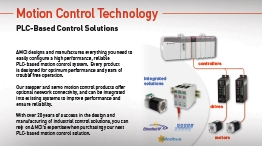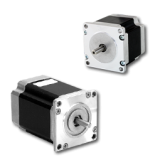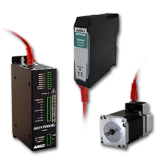How to Size a Motor
Engineers today have an ever growing selection of motion control products to choose from when designing a system. As the variety increases, the need to correctly select the motor solution is becoming critical to ensure the most cost effective design while guaranteeing a reliable and well executed project. That means no longer using overkill or “it’s what we did last time” as a design criteria. Properly sizing the system is a must. In the past this may have been avoided because it was considered difficult or too time consuming. However if a few simple steps are followed the required information can be gathered that will provide direction to the best fit for the application.
Step 1: Define the motion profile
This step can sometimes be the most challenging. How long is the move cycle? Is there a dwell between moves? What is the distance of travel? To understand these questions often times requires the mechanical system to be designed to completion or near completion. Having that completed design will also assist when gathering the information that will allow the correct sizing of the motor.
It is at this step when other specifications or parameters need to be reviewed. Understanding requirements such as resolution, position holding, and stopping accuracy may direct the designer to one motor technology or another such as stepper or servo.
Step 2: Calculate load parameters
To properly size a motor you will need to calculate both torque and inertia. A parameter that is sometimes overlooked is the load moment of inertia or simply put load inertia. By definition the moment of inertia is a measurement of how difficult it is change the rotational velocity of an object. Each and every component of the mechanical system has inertia and must be included when determining the load inertia. The load inertia is critical in overall system performance. If the ratio between the load inertia and motor inertia is too high system performance will suffer. In some instances it can prevent the motor from ever getting motion started.
An inertia ratio between 5:1 and 10:1 is a good guideline for most systems. If high performance, high accelerations are required a ratio of 2:1 or 1:1 may be more appropriate. When the inertia ratio is higher than 10:1 changes to the mechanical system need to be considered. Often times minor changes to a leadscrew pitch or adding a gearbox will provide the desired effect of lowering the inertia ratio to the desired value. This does come with a tradeoff of higher motor speeds to maintain the same output velocity. This is why having motor torque curves handy when selecting the motor is a must.
Once we have the inertia calculated we need to calculate the maximum torque of the system. The maximum torque is the sum of the acceleration torque and frictional torque. Another reason why knowing the motion profile is critical. The higher the required acceleration of the load the higher the acceleration torque and thus a higher maximum motor torque. When there is flexibility in the design it is best to use the lowest acceleration possible thus lending to the lowest acceleration torque. If the acceleration is an unknown a good rule of thumb for calculating the acceleration is to use a trapezoidal motion profile where one third of the move time the motor is accelerating, one third of the time the motor is running constant, and one third of the move the motor is decelerating.
There are several factors related to the load mechanism that have an effect on friction torque. The mechanism chosen can affect friction torque. For example when designing a linear actuator selecting a leadscrew or a ball screw can have a significant impact on friction torque. The types of materials that slide across each other can impact the friction coefficient as well as whether those surfaces are lubricated or unlubricated can ultimately influence the friction torque. These variables can be managed by selecting mechanical components that reduce friction and improve efficiency. These variables highlight why having as much information possible regarding the mechanical system is so important to proper size of the motor.
After the maximum torque has been calculated refer to the speed-torque curve to determine if the motor selected can provide the torque required at the maximum motor speed. This is where understanding the differences between how a servo and stepper are size comes into play. For steppers peak torque is used. A good rule of thumb is to use a safety factor of 1.5 when selecting a stepper motor solution to meet the speed-torque requirement. Once the motor is selected confirm the motor to load inertia ratio is below 10:1. If not consider modifying the mechanical system to reduce the inertia such as adding a gearbox or increasing the pitch if it is a leadscrew mechanism. Doing so will also lower the torque required. But be aware that changing the ratio will increase the motor speed. Double-check the motor can still produce the torque required at the now increased motor speed.
To calculate the necessary parameters you will need to following information:
- Drive mechanism – i.e. direct drive, ball screw, belt pulley, rack and pinion
- Dimensions and mass of the load
- Dimensions and mass of parts
- Friction coefficients of mechanical components
- Motion profile
Other considerations
- Resolution
- Power supply voltage (AC or DC)
- Operating environment (IP rating)
- Motion control components
- System cost
Motion Brochure

PLC-Based Motion Control Solutions: AMCI designs and manufactures everything you need to easily...
PDF DownloadWebinar

A Better Understanding of Motor Selection: Stepper motor? Servo motor? How do you decide which ...
Watch Now




